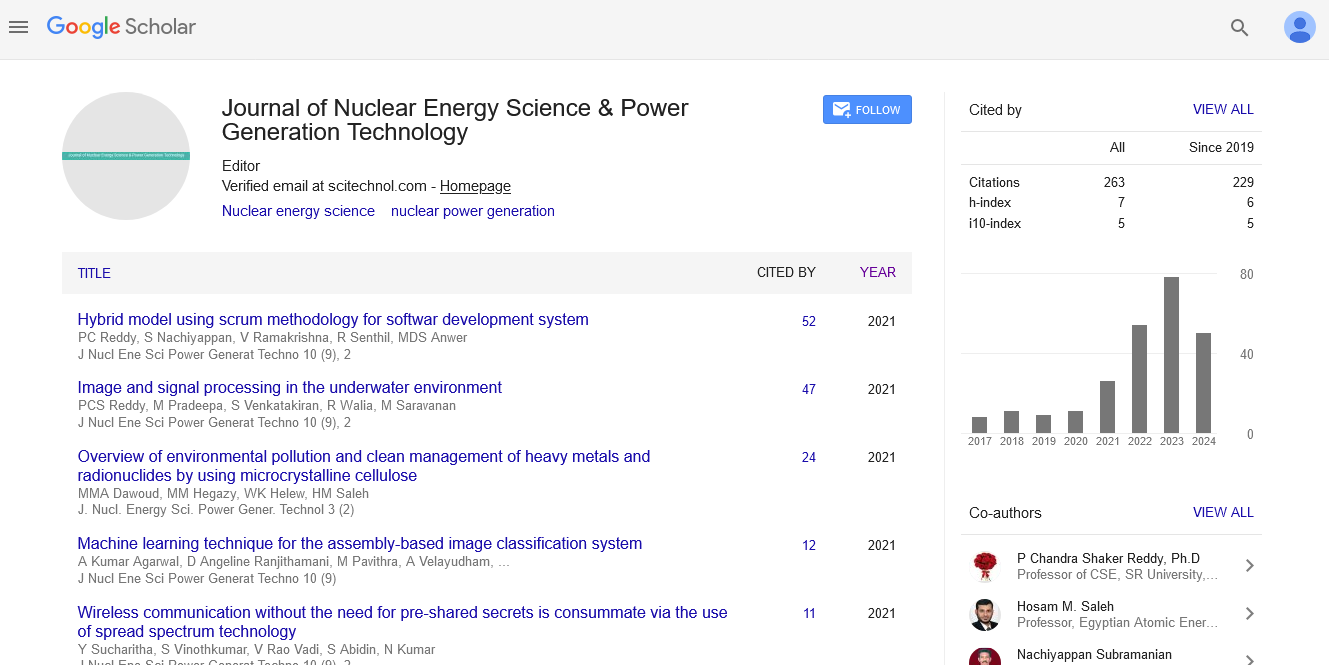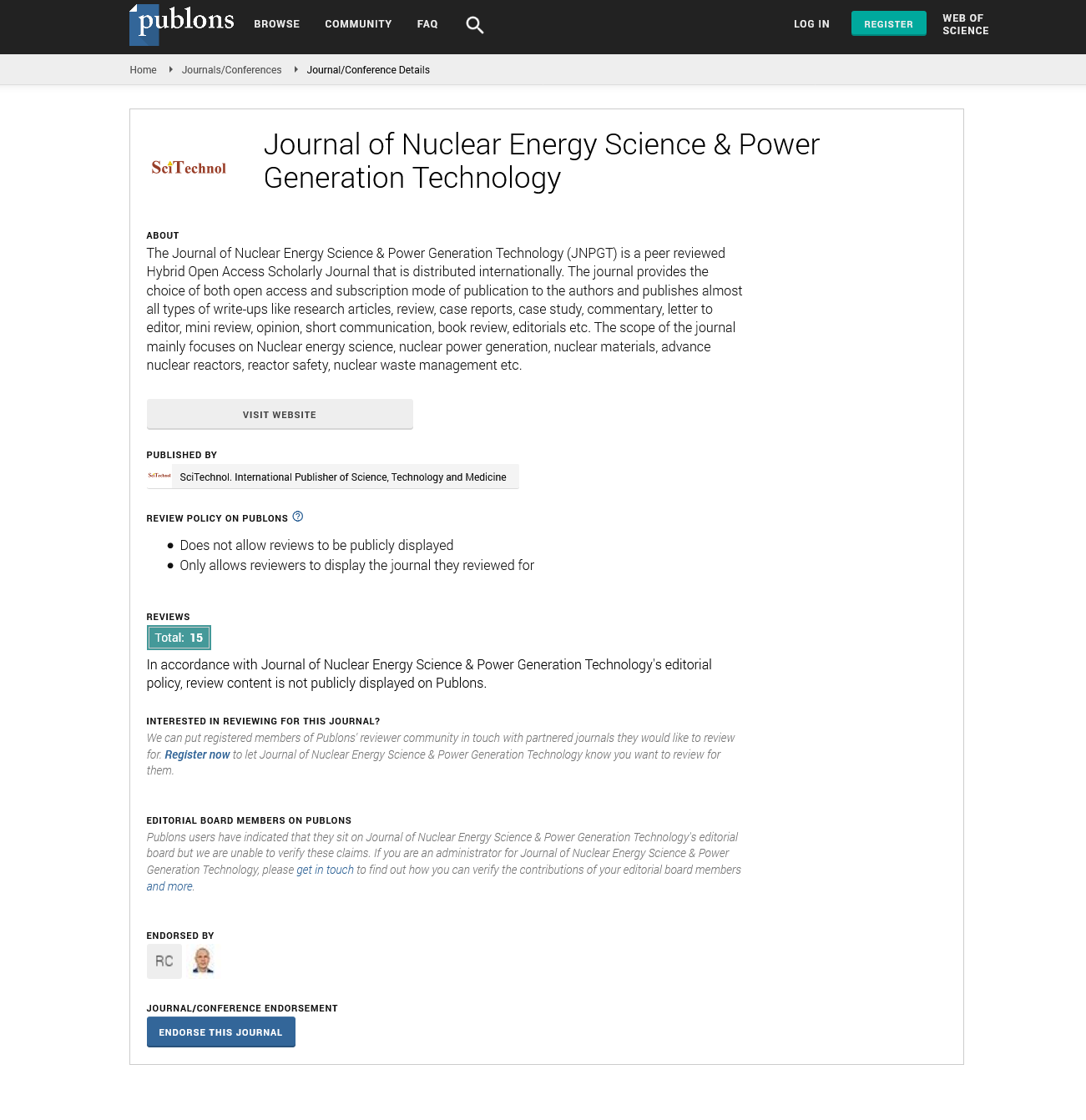Short Communication, J Nucl Ene Sci Power Generat Technol Vol: 13 Issue: 6
Advanced Technologies for Phase Change Materials in Efficient Energy Storage Systems
Jane Smith*
1Department of Nuclear Engineering, University of South Carolina, Columbia, USA
*Corresponding Author: Jane Smith,
Department of Nuclear Engineering,
University of South Carolina, Columbia, USA
E-mail: jane_smith23@gmail.com
Received date: 21 October, 2024, Manuscript No. JNPGT-24-154882;
Editor assigned date: 23 October, 2024, PreQC No. JNPGT-24-154882 (PQ);
Reviewed date: 06 November, 2024, QC No. JNPGT-24-154882;
Revised date: 13 November, 2024, Manuscript No. JNPGT-24-154882 (R);
Published date: 21 November, 2024, DOI: 10.4172/2325-9809.1000432.
Citation: Smith J (2024) Advanced Technologies for Phase Change Materials in Efficient Energy Storage Systems. J Nucl Ene Sci Power Generat Technol 13:6.
Description
Renewable energy sources, such as solar and wind, are intermittent, significance they do not produce energy continuously. For instance, solar panels generate electricity only when the sun is shining and wind turbines depend on wind speed. To maximize the potential of these renewable resources, efficient energy storage systems are necessary to store excess energy when production is high and release it when demand increases or supply drops the importance of energy storage for renewable energy systems, highlighting key technologies and challenges. The intermittent nature of renewable energy generation poses a challenge to grid operators and energy suppliers. In a traditional power grid system, electricity demand and supply must be balanced in real time to ensure a stable and reliable energy supply [1]. However, renewable energy sources often generate power when it is not needed or fall short during periods of high demand. Energy storage systems manage this issue by capturing surplus energy and storing it for later use, thus ensuring a constant supply of power even when renewable energy generation is low.
In addition to providing grid stability, energy storage systems can help reduce the need for fossil fuel-based backup power, thereby decreasing greenhouse gas emissions and improving the overall sustainability of the energy sector [2,3]. As renewable energy generation continues to grow, the ability to store energy efficiently will be vital for achieving a fully decarbonized energy grid. Several energy storage technologies are being developed and organized to support renewable energy integration.
Lithium-ion batteries are the most common energy storage technology due to their high energy density, long lifespan and fast charging capabilities. These batteries are typically used for short-term energy storage and can be organized in both residential and commercial applications [4,5]. Li-ion batteries are ideal for storing solar and wind energy, but their high cost and limited scalability remain challenges for large-scale energy storage. Pumped hydro storage is one of the oldest and most established forms of large-scale energy storage. It involves using excess energy to pump water from a lower reservoir to an upper reservoir. When energy is needed, the water is released, passing through turbines to generate electricity. Although this technology is highly efficient and capable of storing large amounts of energy, it requires specific geographic conditions and significant infrastructure investments, limiting its widespread deployment [6-8]. Flow batteries are an emerging technology that stores energy in liquid electrolytes that flow through a cell stack. These batteries have the advantage of being easily scalable and providing long-duration storage, making them suitable for applications that require energy over extended periods. They are particularly capable for grid-scale storage but are still in the development phase for commercial use. Compressed air energy storage involves compressing air and storing it in underground caverns or tanks during times of low demand. When energy is needed, the compressed air is released, passed through turbines and used to generate electricity. Compressed air energy storage has the potential to provide large-scale energy storage, but it faces challenges related to site selection and efficiency losses. Solid-state batteries are a next-generation energy storage technology that uses a solid electrolyte instead of a liquid one. They provide the potential for higher energy densities, improved safety and longer lifespans compared to traditional Li-ion batteries.
Many energy storage technologies, particularly large-scale solutions, are still relatively expensive. The cost of storage systems must be reduced to make them economically viable for widespread disposition. Sustained advancements in materials science and manufacturing processes will be essential for achieving cost reductions [9]. Different storage technologies have varying capabilities in terms of how long they can store energy and how efficiently they can convert it back into usable electricity. Some systems, like Li-ion batteries, are better suited for short-term storage, while others, like pumped hydro and flow batteries, provide longer durations. Balancing these requirements for different applications is a key challenge. Integrating energy storage systems into existing power grids requires significant infrastructure upgrades. Energy storage systems must be able to seamlessly interact with renewable energy generation and the grid, ensuring that energy is delivered efficiently and reliably to consumers [10]. While energy storage systems provide environmental benefits by supporting the integration of renewable energy, the production and disposal of storage technologies themselves can have environmental impacts. Developing recycling solutions and sourcing materials sustainably will be important for minimizing the ecological footprint of storage systems.
Conclusion
Energy storage is a key enabler for the widespread adoption of renewable energy. By providing solutions to manage the intermittency of renewable sources, storage technologies ensure that clean energy can be reliably delivered to consumers. As advancements continue in energy storage technologies and their integration into grid systems can expect a more sustainable, resilient and efficient energy future powered by renewables. The future of energy storage for renewable energy systems lies in continued innovation, collaboration between industries and investment in research and development. With the right combination of technological advancements and policy support, energy storage can play a vital role in enabling a cleaner, more sustainable energy future.
References
- Casamirra M, Castiglia F, Giardina M, Lombardo C, Celata GP et al. (2005) Rewetting of a hot vertical surface by liquid sprays. Exp Therm Fluid Sci 29:885-891.
- Cheng SC, Lau PWK, Poon KT (1985) Measurements of true quench temperature of subcooled water under forced convective conditions. Int J Heat Mass Transf 28:235-243.
- Roth GA, Aydogan F (2014) Theory and implementation of nuclear safety system codes-Part II: System code closure relations, validation and limitations. Prog Nucl Energy 76:55-72.
- Karwa N, Gambaryan-Roisman T, Stephan P, Tropea C (2011) Experimental investigation of circular free surface jet impingement quenching: Transient hydrodynamics and heat transfer. Exp Therm Fluid Sci 35:1435-1443.
- Bogdanic L, Auracher H, Ziegler F (2009) Two phase structure above hot surfaces in jet impingement boiling. Heat Mass Transf 45:1019-1028.
- Islam MA, Monde M, Woodfield PL, Mitsutake Y (2008) Jet impingement quenching phenomena for hot surfaces well above the limiting temperature for solid liquid contact. Int J Heat Mass Transf 51:1226-1237.
- Carbajo JJ (1985) A study on the rewetting temperature. Nucl Eng Des 84:21-52.
- Fang X, Chen Y, Zhang H, Chen W, Dong A et al. (2016) Heat transfer and critical heat flux of nano fluid boiling : A comprehensive review. Renew Sust Energ Rev 62:924-940.
- Filipovic J, Incropera FP, Viskanta R (1995) Rewetting temperatures and velocity in a quenching experiment. Exp Heat Transf 8:257-270.
- Mozumder AK, Monde M, Woodfield PL, Islam MA (2006) Maximum heat flux in relation to quenching of a high temperature surface with liquid jet impingement. Int J Heat Mass Transf 49:2877-2888.
 Spanish
Spanish  Chinese
Chinese  Russian
Russian  German
German  French
French  Japanese
Japanese  Portuguese
Portuguese  Hindi
Hindi 

